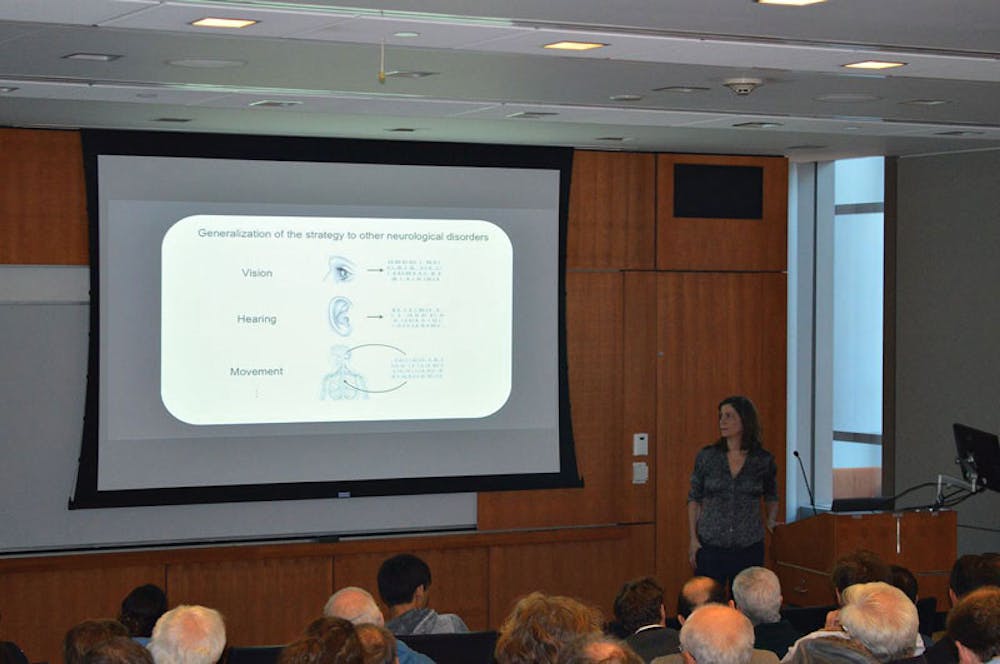When neuroscientist Sheila Nirenberg received a call from a mysterious number a month ago, she did not expect to hear from the MacArthur Foundation, announcing she’d won the prestigious $625,000 MacArthur Fellowship.
“I thought the call was from a guy I’d gone on a date with,” said Nirenberg, a professor at the Weill Medical College of Cornell.
Nirenberg’s past work on neural coding has led to the creation of prosthetics that have helped blind mice see and could potentially treat blindness in humans.
Yesterday Nirenberg explained her past and current research in this field at a lecture hosted by the Center for Vision Research at the Brown Institute for Brain Science.
Students, faculty and community members filled Marcuvitz Auditorium in Sidney Frank Hall to hear Nirenberg speak.
Nirenberg said her research could benefit more than 2 million people in America with advanced-stage blindness and others from around the world suffering from retinal diseases such as macular degeneration and retinitis pigmentosa. Current treatments, such as drug therapy, only help a small fraction of the population and current prosthetics offer nothing close to normal vision. The current technology provides blind people with very limited perception — they are able to see bright lights and high contrast edges but are unable to distinguish faces or landscapes, Nirenberg said.
In contrast, Nirenberg’s prosthetic device creates nearly normal vision and allows for the perception of detail. The prosthetic accomplishes this by translating visual information from the outside world into a language the brain can understand.
In normal eyes, visual signals are translated into electrical pulses that serve as a code that the brain interprets. In many cases of blindness the ganglion cells — the cells that communicate the visual information from the retina to the brain — remain intact. The circuitry that provides these cells with input, however, is rendered non-functional. Because the ganglion cells do not receive any signals, the brain receives no visual information.
The prosthetic device created by Nirenberg and her team stands in for this dysfunctional circuitry in a blind eye. The prosthetic has two parts: an encoder and a transducer. The encoder is a chip implemented with a set of equations that translate visual information from the outside world into patterns of electrical impulses similar to those produced by a normal retina. The transducer then drives ganglion cells to fire as the code dictates, relaying information to the brain.
In this way, the prosthetic has been used to produce nearly normal vision in blind mice. Mice with the prosthetics could discern facial features and visually track images, according to a previous study conducted by Nirenberg. The prosthetic was also tested on monkeys with induced blindness and achieved the same result.
The human version of the prosthetic would consist of a pair of glasses serving as the encoder and a channelrhodopsin virus injected in the eye serving as the transducer. Nirenberg warns that the glasses are not slim and fashionable like her lecture graphic suggests, “they are more like ski goggles.”
There are a lot of hoops, such as Food and Drug Administration approval, that Nirenberg has to jump through before her human-based research can launch and prosthetics are made available to the public, she said. She predicts clinical trials on humans will begin in two years.
Nirenberg’s research also opens other doors. Increased understanding of the neural code may help address dysfunction within the motor and auditory system as well, she said.
Though Nirenberg is now a recipient of a “Genius” award, Senior Lecturer in Neuroscience John Stein described Nirenberg’s modesty while introducing at the beginning of the lecture. Ivana Petrovic GS, a student from Siberia who studies applied math, said she was willing to skip an important class to attend the talk.
When Nirenberg is not conducting research, she has dinner at fancy restaurants in New York City with possible investors, she said. There may never be a cure for blindness and it may take time for prosthetics to become readily available, but Nirenberg has already found a cure for sadness — watching movies on Netflix.

ADVERTISEMENT




